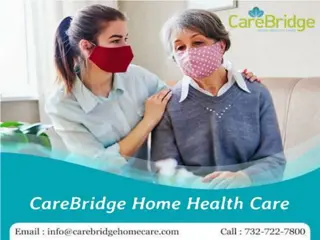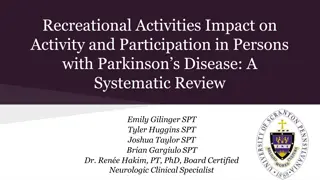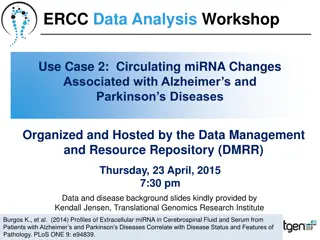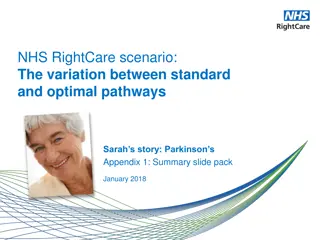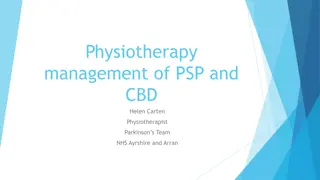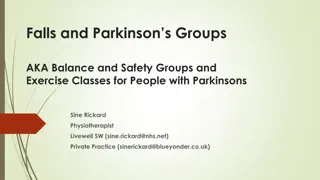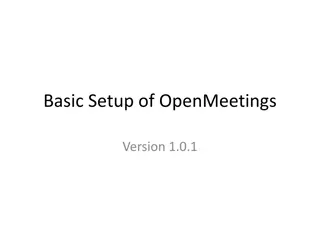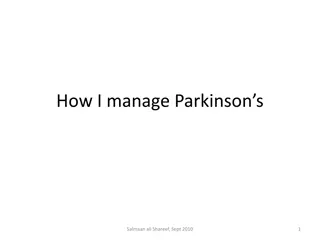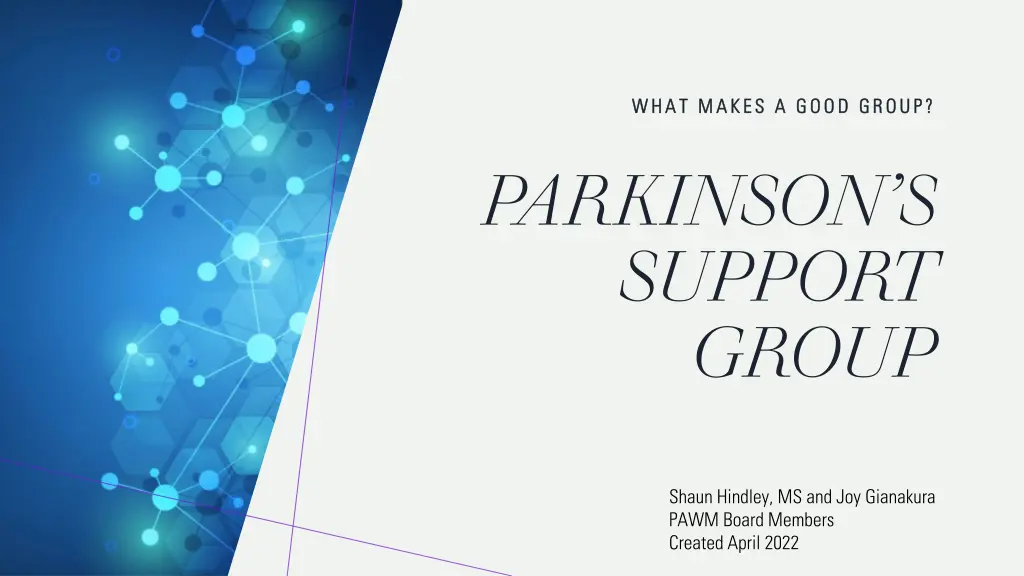
Effective Strategies for Parkinson's Support Groups
Explore the key components that make a Parkinson's support group successful, including types of groups, social interactions, education, and the importance of balancing social dynamics. Learn how these groups provide valuable benefits for patients and caregivers dealing with the long-term challenges of Parkinson's disease.
Download Presentation

Please find below an Image/Link to download the presentation.
The content on the website is provided AS IS for your information and personal use only. It may not be sold, licensed, or shared on other websites without obtaining consent from the author. If you encounter any issues during the download, it is possible that the publisher has removed the file from their server.
You are allowed to download the files provided on this website for personal or commercial use, subject to the condition that they are used lawfully. All files are the property of their respective owners.
The content on the website is provided AS IS for your information and personal use only. It may not be sold, licensed, or shared on other websites without obtaining consent from the author.
E N D
Presentation Transcript
WHAT MAKES A GOOD GROUP? WHAT MAKES A GOOD GROUP? PARKINSON S SUPPORT GROUP Shaun Hindley, MS and Joy Gianakura PAWM Board Members Created April 2022
CONTENT General information on Support Groups Types of Support Groups Social Interactions Support Group Education and Information Support Group Do s and Don ts In Person Meetings Virtual Meetings Exercise
GENERAL INFORMATION SUPPORT GROUPS What makes a PD support group unique? Patients are in for the long haul (5 years or more), not just a few months to a few years like most support groups. Patients can live for 20 or more years with PD A PD patient usually has a caregiver in tow. Since PD can be an everything disease, some patients become absorbed by the disease. PD can vary widely from patient to patient PD patient would normally see their doctor about twice a year.
Educational This type of group has a leader that organizes speakers to talk at each meeting. The speakers provide information on the disease. Patients can ask questions related to that particular meeting. Very little social interaction with other patients Social TYPES OF SUPPORT GROUPS This type of group has leader, the leader may be more of a moderator. This allows for social interaction. Very little educational information about the disease Both This type of group combines both information and social interaction. This may be the most difficult type of support group to lead; however, for a PD support group this type of meeting is the best since it informs the patient and meets the needs of the patient.
SOCIAL INTERACTION Balancing social interaction Without a balance, the meeting could become a free for all (chaos). Some individuals may dominate the meeting. This is not helpful for the patient. Moderator must Control the meeting Allow all individuals who want to talk, speak Guide the discussion as needed or necessary
SOCIAL INTERACTION Benefits The patient learns from other patients. For a disease like PD, this is paramount. Likewise, the caregiver learns from other caregivers. The patient is able to speak openly and honestly. They are heard from others. The patient and caregiver is supported by the other members of the group. The patient has a voice important since this is a life-long disease and the patient usually only sees their doctor twice a year.
EDUCATION AND INFORMATION Benefits Since the disease is permanent and uncurable continued education and information can Help the patient with daily living. Provide some hope from research. Help with Quality of Life. Building community and a sense of belonging (patient and caregiver). Building empathy for the patient. Draw Backs The patient can live and breath PD in an unhealthy manner. This may lead to trying new (untested) products.
DOS AND DON TS Start and stop on time. Be prepared anything could happen. It is okay to control the meeting but this might also offend some people. Start with ice-breaker questions. Don t allow select individuals to dominate the meeting. As the leader, don t dominate the meeting unless you are the speaker. Be respectful of others (Parkinson s Disease is difficult).
IN PERSON SUPPORT MEETINGS OPERATIONAL TIPS Secure a space for meeting that is accessible. The room should be friendly and the correct size for the group. Ideally, a first level location can be secured, but if not, consider elevator location and distance to the room location once in the building. Provide a map for attendees to know where to park and how to locate the room you are holding the meeting in. (Ensure ample parking is available.) Know the space prior to holding your meeting there. If there are doors, consider lever-style handles rather than rounded knobs, as well as automatic door access. (Consider this for restroom access as well.)
IN PERSON SUPPORT MEETINGS OPERATIONAL TIPS continued If possible, provide a variety of seating options (soft seating, low chair, chairs with armrests). Make sure the facility has all exits marked and an emergency plan in place. Communicate the emergency plan to all attendees. In large rooms, keep in mind that some of the patients might be hard of hearing.
CHALLENGES OF VIRTUAL OPERATIONAL TIPS Computer set up needs to be simple so that all can join. Use Zoom or Teams. Have a computer expert available if problems arise while streaming. Assure the link is available to all participants in advance Enable mute participants upon entry feature to avoid background noise and confusion. Utilize chat for those with vocal issues (loudness, etc.), and assign a co-lead to monitor the chat for questions & comments.
CHALLENGES OF VIRTUAL OPERATIONAL TIPS continued Consider using closed caption settings in Zoom: Log into the zoom app and select the settings gear button. Click on accessibility and choose settings for your meetings including closed captioning. The size of the chat text is also a setting, and you can enlarge the text for ease of reading. At the start of a meeting, the host can click the Live Transcript button and Enable Auto-Transcription. Consider recording the session for archiving and for participants to listen/watch again at a later date. When using the breakout group function, make sure someone in the group is available to assist with overall communication and to keep the conversations flowing and all participants engaged.
A REMINDER ABOUT EXERCISE Parkinson s patients should be encouraged to exercise as much as possible Any exercise is good. Choose exercise that you like. Biking, running, dancing, aerobics Virtual Reality Supernatural is a great VR exercise system.
Questions? You can send a message to info@parkinsonswm.org. The Parkinson s Association of West Michigan helps patients and caregivers, primarily in West Michigan and beyond, navigate the effects of the disease. We are here to help you also. Website: www.parkinsonswm.org Resources: https://www.parkinsonswm.org/resources/ Events: https://www.parkinsonswm.org/active-events-calendar/ Contact Us: https://www.parkinsonswm.org/contact-us/


